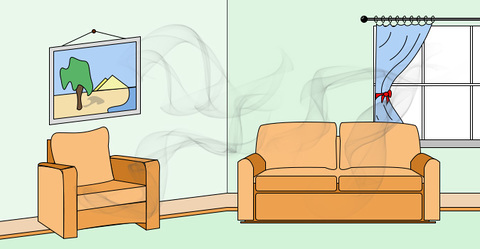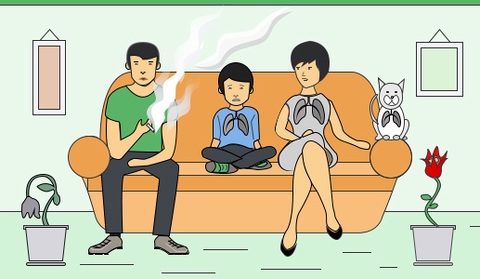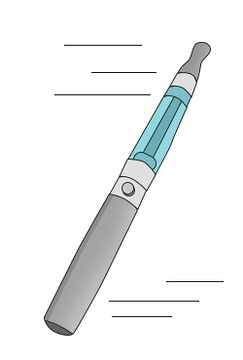Environmental tobacco smoke (ETS) is a major air pollutant. It is also one of the most dangerous of all. As a leading cause of indoor air pollution, it not only impacts the smoker, but those around them as well.
What is ETS?

ETS, also known as secondhand smoke (SHS), is a mixture of the smoke exhaled by the tobacco user (mainstream smoke) and the smoke emitted from a lit cigarette, cigar, hookah, or pipe (sidestream smoke). The amount of smoke created by a tobacco product depends on the amount of tobacco available for burning. Secondhand smoke emitted by smoking one large cigar is similar to that emitted by smoking an entire pack of cigarettes. Sidestream smoke has a higher concentration of cancer-causing agents, called carcinogens, and is made up of smaller particles, making it easier to enter the lungs.
Those who inhale ETS are at risk for the same health complications that smokers are. When nonsmokers are exposed to secondhand smoke, it’s called involuntary smoking or passive smoking. Non-smokers who breathe in SHS take in nicotine and toxic chemicals just as smokers do. That being said, the more you inhale ETS, the more dangerous it becomes. In fact, secondhand smoke causes approximately 3,000 deaths per year to non-smokers.
Note that simply separating smokers from non-smokers does not get rid of ETS. Someone smoking in a room on the first floor of a home can affect someone in a room upstairs. Smoke can travel between rooms and even up stairwells and through vents. Aside from breathing in the harmful smoke, there are also deadly chemicals that stick around in your home -- like on drapes, linens, furniture, and clothes. This is called thirdhand smoke.
Thirdhand Smoke

Thirdhand smoke is a relatively new concept. Its risks are still being studied and researched, but there is enough information out there to know that it is dangerous. The effects of ETS can persist over time in ways one would not readily expect. Walls will visibly change color and breathing will become more difficult. Not only that, but a sticky, yellow residue will be found on all kinds of things inside your home. It may just seem like any other old stain, but the residual contamination is increasingly dangerous. Tobacco toxins remain harmful, even after it was breathed or ingested.
The nicotine in tobacco smoke reacts with nitrous acid, which is a common component of indoor air. This leads to the formation of hazardous carcinogens. Nicotine remains on surfaces for days and weeks, meaning the carcinogens continue to be created, which are then inhaled, absorbed or ingested. Keep in mind that there is no risk-free level of tobacco exposure.
Thirdhand smoke is especially dangerous to children. The toxic residue is known to stunt the growth of babies and weaken their immune systems. Also, considering toddlers crawl around and put objects in their mouths during development, they are more likely to come into contact with pollutants. Babies and children are closer to surfaces like floors. They tend to touch or put their mouths on everything, including the contaminated surfaces. Imagine a teething infant...everything is going into that baby’s mouth.
Children ingest twice the amount of dust that grown-ups do. Much of the residue created by ETS can be found in the dust in your home. You are constantly breathing it in, and so is the child. Taking their small statures into account, children experience 20 times the exposure to thirdhand smoke. Pets are at risk too, since they’re always playing with toys and rolling around on the floor.
Really, there’s no way of escaping the effects. You can try to air out your home and clean it to get rid of some of the particles, but the damage has already been done. The only real way to fix it is to stop smoking. Even if you smoke outside, thirdhand smoke will cling to your clothes and hair, meaning you are still exposing others to it.
Smoking in Your Car
Smoking inside means smoking inside your car too. The small, confined space of your car will strengthen the unsafe effects of ETS. It’ll damage your car too. Cleaning has little or no effect on the levels of total smoke pollution inside the vehicle. In other words, smoke still sticks to surfaces of the car no matter how much you scrub your upholstery. Ventilation efforts, like using the air conditioner or holding a cigarette close to or outside a rolled-down window, don’t really do anything either.
The thirdhand smoke inside a vehicle is also dangerous. The toxic air in the interior of your car is highly hazardous and it can cling to every part of it for days, weeks, or even months. If you have children in your car, even while not smoking, they will be harmed by the chemicals. Everything you or they touch is toxic. If you smoke, avoid doing so in your car especially.
Why is Air Quality Important?
Breathing quality air is essential for our well-being. Walking through your front door and being greeted by a cloud of smoke seems much more creepy than inviting… The creepiest part of all is the cancerous particles lingering in the air, jeopardizing your and your loved ones’ health. It’s more than just that annoying smell and lingering haze.
ETS contains over 4700 chemical compounds including arsenic (rat and ant poison), benzene (rubber cement), lead (car battery material), phenol (used in production disinfectants and plastic), and hydrogen cyanide (poison used in gas chambers). Carbon monoxide is also produced at levels well above the acceptable standard for human exposure.

Scientific studies show that smoking indoors drastically increases the concentration of air pollutants. Rooms that are smoked in have hazardously high levels compared to rooms that are not smoked in. The levels of ETS in a room depend on the air exchange rate. In a low-exchange environment, the particles may slowly spread out and persist. Similarly, in an area with greater ventilation, ETS may be diluted more quickly. Some studies have shown higher consistent levels when air is re-circulated, such as in air conditioned environments.
What is Being Done?
In the United States, steps have already been taken to reduce levels of exposure. Legislation has been operative in making a difference for communities. Federal law bans smoking on all domestic airline flights, nearly all flights between the United States and foreign destinations, interstate buses, and most trains. Smoking is also banned in most federally owned buildings. Many state and local governments have also passed laws prohibiting smoking in public facilities, such as schools, hospitals, and airports, as well as private workplaces, including restaurants and bars.
Many communities are working to establish more and more smoke-free environments. From lobbying to protesting, people are out trying to make a difference. Many individuals do not realize the severity of the situation. The harrowing effects of ETS are long-lasting and oftentimes, lethal.
How it Affects General Health

As most people know, smoking isn’t good for you. It’s pretty harmful to your health and it can even kill you.
- Secondhand smoke significantly increases the risk of lung cancer, as well as cancers of the breast, lymphatic system, blood, larynx, throat, sinuses, brain, bladder, rectum, and stomach. Thirdhand smoke, the residue left on different objects around your home, also contain carcinogens that cause cancer.
- Exposure to tobacco smoke also puts people at risk for cardiovascular disease. Even though active smokers are more likely to develop this ailment, The American Cancer Society says as many as 42,000 non-smokers die annually from cardiovascular disease due to exposure to secondhand smoke. SHS causes coronary heart disease and stroke.
- Lung cancer isn’t the only way your lungs can be affected by tobacco smoke. Chronic obstructive pulmonary diseases are possible too, such as emphysema and chronic bronchitis. Asthma in children and adults may also worsen.
How it Affects Children

As mentioned previously, children are especially at risk. During early stages of development, exposure to smoking can be life-threatening.
- ETS exposure increases the risk of lower respiratory tract infections such as bronchitis and pneumonia. 150,000-300,000 of these cases occur annually in infants and young children.
- It drastically increases the possibility of ear infections.
- ETS irritates the upper respiratory tract and is associated with a small but significant reduction in lung function.
- Children who have parents who smoke frequently become sick and miss school.
- Wheezing and coughing are more common in children exposed to secondhand smoke.
- Asthmatic children will experience an increase in the severity of their symptoms. Up to 1,000,000 asthmatic children have their condition worsened by secondhand smoke.
- ETS also contributes to new cases of asthma in children who had not previously shown symptoms.
- Secondhand smoke is directly related to Sudden Infant Death Syndrome (SIDS).
- Smoking can also affect babies while they are in the womb, or even before conception. It increases the risk of miscarriage, premature birth, and stillbirth.
- Women who smoke are also more likely to have babies with low birth weights and lengths.
- Children may also develop a learning disability and attention deficit/hyperactivity disorder (ADHD).
How it Affects Pets

Pets have hearts and lungs too, meaning they too are affected by secondhand smoke. Animals, in this case, should be treated as infants, in a way, as they do not know that certain things can hurt them.
- Pets may ingest cigarette butts or empty packs. This can cause tremors, lack of coordination, convulsions, excessive salivation, respiratory failure, weakness, and in extreme cases, death.
- Secondhand smoke can be very dangerous to pets’ lungs and hearts. Smoking around your pet can affect their respiratory system and even cause diseases.
- Dogs are known to develop nasal cancer, allergic skin disease, lung disease, emphysema, and canine heart disease.
- Cats exposed to ETS are at a higher risk for the common tumor, lymphoma. They may also develop oral cancer.
- Pets are also known to experience gene mutation and DNA changes after being exposed to secondhand smoke for a prolonged period of time. This is similar to what happens in humans as a result of the carcinogens.
- Thirdhand smoke is also a hazard to pets. Lots of dogs, for instance, like to roll around on the carpet and rub themselves against walls. This means the toxins in the residue will cling to your pet as well.
Risks of Radon for Smokers
Radon can cause health problems for smokers and non-smokers alike. It is the number one cause of lung cancer and is found in homes all over the United States. Radon is a naturally occurring radioactive gas and a silent killer. It comes from the breakdown of uranium & is emitted from the earth. It’s tasteless, colorless, and odorless. You may not even know you are being exposed to radon in your home. And, if you’re a smoker, it’s much worse. Radon is already seriously damaging your lungs, so mixing smoke with it is just a recipe for disaster. Radon can enter your home through cracks in your foundation, well water, building materials and other sources. It will then become trapped inside and part of the air you breathe.
Most people wouldn’t even live in a home without a smoke detector, but don’t bother thinking about radon. In fact, radon actually kills more than seven times the people each year as home fires do. Any home, old or new, can have a radon problem. Radon is measured in "picocuries per liter of air," or "pCi/L." To test your home, simply purchase and install a radon gas detector. If your home is at or above 4 pci/L, you should take corrective measures immediately.
The EPA has provided the following chart to showcase the risks associated with smoking and radon exposure.
| Radon Level | If 1,000 people who smoked were exposed to this level over a lifetime*... | The risk of cancer from radon exposure compares to**... | WHAT TO DO:
Stop smoking and... |
|---|---|---|---|
| 20 pCi/L | About 260 people could get lung cancer | 250 times the risk of drowning | Fix your home |
| 10 pCi/L | About 150 people could get lung cancer | 200 times the risk of dying in a home fire | Fix your home |
| 8 pCi/L | About 120 people could get lung cancer | 30 times the risk of dying in a fall | Fix your home |
| 4 pCi/L | About 62 people could get lung cancer | 5 times the risk of dying in a car crash | Fix your home |
| 2 pCi/L | About 32 people could get lung cancer | 6 times the risk of dying from poison | Consider fixing between 2 and 4 pCi/L |
| 1.3 pCi/L | About 20 people could get lung cancer | (Average indoor radon level) | (Reducing radon
levels below 2 pCi/L is difficult.) |
| 0.4 pCi/L | About 3 people could get lung cancer | (Average outdoor radon level) |
Vaping
Vaping is a tobacco free, sometimes even nicotine-free, alternative to smoking. The popularity of vaping has skyrocketed over the past few years. It’s a trend that’s taken over; many people have switched to vaping in efforts to quit smoking cigarettes or to quit smoking entirely. Vaping is exponentially safer than smoking and much better for the environment.

It’s the act of inhaling and exhaling water vapor produced by e-liquid in a vaporizer/e-cigarette. The water vapor is, essentially, the e-liquid in gas form. It usually appears much thicker than smoke and smells a lot better too. From key lime pie and strawberry daiquiri to sprinkled donut and caramel macchiato, the e-liquid flavors are endless. Instead of purchasing packs of cigarettes, you purchase vials of e-liquid and simply refill and recharge your vaporizer as needed. So, what are the “hazards” of vaping? Scientists argue that vaping could potentially put your health at risk, but there is not enough concrete evidence to support such claims. The e-liquids you can purchase have varying levels of nicotine, meaning users have varying levels of intake. However, nicotine isn’t the primary antagonist -- nicotine is what can addict you to cigarettes, thereby exposing you to the cancer-causing chemicals they contain. Nicotine isn’t what causes lung cancer, it causes addiction. Although, nicotine is still bad for you and pregnant women should not use anything that contains it.
The water vapor exhaled actually has less contaminants than your breath. That being said, “secondhand vapor” does not pose any immediate threats to bystanders or the environment. Some scientists warn against vaping around children, as studies show it could affect brain development. However, vaping is seen as at least 95% safer than smoking, despite the fact that some e-liquids may contain some dangerous ingredients. Environmentally, vaping is astronomically better. When liquid nicotine is vaporized, the e-cigarette only produces water, nicotine gas and propylene glycol. Nicotine and water are naturally occurring gases and propylene glycol is an organic compound. That means the air in your home won’t be toxic...it’ll just smell like cotton candy.
What You Can Do
Even though ETS is a fatal pollutant, it is pretty easy to eliminate. As mentioned before, indoor air quality is immensely important. You and your loved ones can breathe easy by just eliminating the source.
Consider making your home smoke-free. Smoke only outside or don’t smoke at all. Kindly ask guests to not smoke inside your home and to go outside if they need to.
Quit smoking. If you or a loved one is looking for a reason to stop smoking, just think of all the harmful effects the habit has on those you care about. This community online can help you along the way. Other ways of quitting include:
- Behavioral therapy
- Nicotine replacement therapy
- Medication
- Nicotine gum
- Nicotine patches
You should seek the support of your friends and family and get rid of all triggers. Planning out the process and finding focus are crucial.
Switch to vaping. You can easily go online or to your local smoke shop and buy a vaporizer to start vaping. There are lots of resources online to help you get started. Check out this website. Vaping can also help you quit smoking.
Do a deep cleaning of your home. Remove all curtains, sheets, towels, and other linens from the home and wash them thoroughly. Steam clean all of the carpets and use a deodorizing product. Sanitize your ceilings, floors, countertops, and other fixtures in your home with a solution of water and bleach. Also consider repainting the walls and doors. Opening the windows will help air out the home too.
Use an air purifier or filter. Air purifiers can help with the odors caused by cigarette smoke and reduce SHS. These purification systems work by pulling indoor air into their them, cleaning it, and then circulating it back into the room. Mechanical air filters, such as high-efficiency particulate air (HEPA) filters, and electronic air cleaners, such as ionizers, target the ETS particles.
Choose smoke-free environments. When going out to restaurants or booking hotels, do your research. Make sure that these places are smoke-free. Being exposed to ETS for just a couple of hours can take a toll on your health. If you work in an environment that is not smoke-free, talk to your employer about creating a designated smoking area or banning it. You should also verify whether or not they are complying with federal and state law.

.webp)
.webp)
.webp)
.webp)








